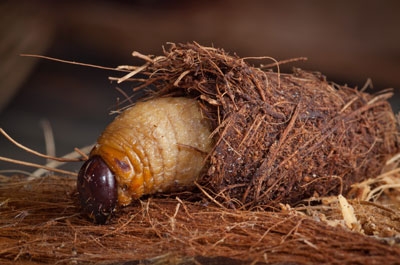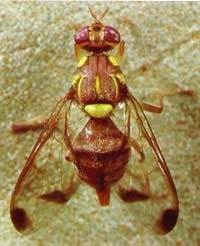Posts Tagged: exotic pest
Another palm tree infested with red palm weevil
Officials have confirmed that the red palm weevil is not confined to a single palm tree in Laguna Beach, according to a story in the Daily Pilot. Just blocks from the first infested tree, another Canary Islands date palm is being killed by red palm weevil.
UC Riverside Cooperative Extension entomologist Mark Hoddle said the crown of the second infested palm has dropped off, and the top of the trunk is ringed with a 'halo' of palm fronds.
"The trunk of the palm has been heavily damaged internally by feeding red palm weevils. The central portion of the trunk now contains a highly fermented and very wet 'mash' of plant material," the story quoted Hoddle.
The dying tree contained portions of at least nine dead adult weevils, one live adult and seven empty pupal cases.
It is now likely that additional palms in North Laguna are infested with this destructive pest, the story said.
CDFA, the Orange County Ag Commissioner, USDA and UC Cooperative Extension are hosting the first of several informational meetings from 10 a.m. to 12 noon Friday, Nov. 5, in the Laguna Beach City Council Chambers, 505 Forest Ave. At the meeting, experts will inform local government officials, arborists, public works officials, landscapers and pest control advisers about the current red palm weevil situation and how to identify the pest and its feeding damage.
Future meetings will target other industry members and the public.
Details about the meeting and more information are on the UC Riverside Center for Invasive Species Research blog.
Southern California Public Radio's Madeline Brand interviewed Hoddle about red palm weevil for a story broadcast last Friday.

Red palm weevil larva emerges from its cocoon.
Red palm weevil found in Orange County
Palm tree growers, government officials and UC scientists are moving quickly to prevent the spread of red palm weevil, which made its first U.S. appearance a month ago in Laguna Beach, according to an article in the Riverside Press-Enterprise. The pest has caused enormous damage to palm trees in other parts of the world. Its larvae excavate large holes in the trunks of many types of palms - including coconut, date and oil palms, canary, queen and fan palms - killing a mature tree in about a year.
"This is central to our livelihood," the story quoted Albert Keck, chair of the California Date Commission and a third-generation date farmer.
Press-Enterprise reporter Mark Muckenfuss noted in the story that concern about the palm tree pest goes well beyond farmers' pocketbooks. Palm trees add a distinctive character to local landscapes.
"Palms are iconic to California," Keck was quoted.
Originally from Southeast Asia, the red palm weevil has spread to Africa and Europe, reaching the Mediterranean in the 1980s. It was first recorded in Spain in 1994.
UC Riverside entomologist Mark Hoddle said the weevil was probably brought into the United States as eggs, larvae or pupae hidden inside imported palms.
"These can travel great distances because they live with their food supply," Hoddle said.
A UC Riverside news release said scientists, growers and regulators will gather at 2 p.m., Friday, Oct. 29, at UC Riverside to discuss a collaborative effort to manage red palm weevil and a campaign to alert and educate Southern California homeowners about the threat.
Detailed information about red palm weevil is on the UC Center for Invasive Species Research website.

Red palm weevils are quite large and have a slender snout.
Melon fruit fly found in Kern County
Farmers and ag officials will gather at the UC Cooperative Extension office in Kern County at 6 p.m. Wednesday to discuss the recent discovery of five melon fruit flies southeast of Bakersfield, according to an article in Western Farm Press.A native of Asia, melon fruit flies' only U.S. home currently is in Hawaii. However, CDFA says it poses a significant threat to a wide variety of agricultural crops important to California, including peaches, oranges, beans, tomatoes and most crops in the cucumber family.
To eradicate the flies already in Kern County, the agricultural commissioner's office and CDFA are using a "male attractant" for trapping within a 4.5-mile quarantine area and have increased trapping densities to 1,000 traps per square mile within a nine-mile grid, said the Western Farm Press article.
In a news release, the Kern County Agriculture Department implored residents to help prevent the introduction of exotic insects and diseases.
"When returning from a trip out of state, please do not bring back prohibited vegetables, fruits, or other plants, because there could be an insect pest or a plant disease hitching a ride with you," the release quoted ag commissioner Ruben Arroyo. "Foreign insects and plant diseases can kill or significantly harm native species, destroy landscaping, commercial and homegrown fruits and vegetables, increase the use of pesticides, and add extra costs to California’s agriculture industry - costs that will get passed along to you the consumer."

Melon fruit fly is about the size of a house fly.
European grapevine moth funding for growers
At a press conference in Fresno Wednesday, the Natural Resources Conservation Service announced a $1 million cost sharing program to help combat European grapevine moth in California.
The support will cover half the cost of voluntary, environmentally friendly control options, according to the NRCS press release. The pest control strategies, the release said, were developed and approved for use over the past five years by NRCS and the University of California Cooperative Extension. The cost of the treatment is about $208 per acre; NRCS will provide $104 per acre.
"Our intention is to complement the efforts of our partners at CDFA and USDA APHIS who have both the expertise and authority for overseeing infestations of EGVM," NRCS state conservationist Ed Burton is quoted in the release. "We will provide some very targeted Integrated Pest Management tools to farmers who are growing grapes in close vicinity to trapped moths."
Farmers must apply for the funding by June 23.
The Fresno press conference was covered by a number of media outlets, including:
- The Fresno Bee
- KMPH Channel 26 news (Fox affiliate)
- KFSN Channel 30 news (ABC affiliate)
- CBS Channel 47 news
The press conference came a day after USDA Animal and Plant Health Inspection Service announced it released an additional $1.75 million in Farm Bill funding to stem the spread of European grapevine moth in California.
European grapevine moth in Fresno County
Fresno County Agricultural Commissioner Carol Hafner held a news conference yesterday to outline efforts to combat European grapevine moth after three were detected last week in Fresno County. The ag commissioner's office has been monitoring thousands of traps in the county as part of a statewide program to detect the invasive pest.
On April 28, the officials confirmed that two European grapevine moths were found in separate traps about a half mile apart in vineyards southeast of the city of Fresno. On May 1, one moth was found in a trap in the Kingsburg area.
Grape production is the No. 1 ag industry in Fresno County, with an annual value of more than $700 million. The new threat to the industry posed by European grapevine moth was covered widely by local media, including:
Earlier this week, the Fresno Bee reported that USDA is providing California with an additional $1 million to help fight the spread of the European grapevine moth, now found in five California counties. The federal agency had already allocated $1.7 million to deal with the pest.

Fresno grape industry threated by exotic pest.

